Revolutionary Mexico-Study of the Amecameca 20 Centavos
by Scott Doll
Introduction
Amecameca is a small town in the eastern panhandle of the State of Mexico and located approximately 35 miles southeast from Mexico City. During the Mexico Revolution (1910-20), this area was one of the strongholds of Emiliano Zapata and his army known as Zapatistas. Coin shortages were widespread during the revolution and many states and municipalities under Zapata’s control were prolific in minting coins. Amecameca was no exception and arguably had some of the crudest coinage of the revolution.
Amecameca coinage which is undated, hand-stamped, and incuse in design were authorized by General Trinidad Sánchez Tenorio. Most, if not all, of the coins were reported to have been minted from metal salvaged from railroad tank cars used in the transport of molasses to a brandy factory in the area. It is believed that these coins were minted during 1915-1916.
The Amecameca 20 centavos coins were minted in both brass and copper on various size planchets and consists of basically two primary types. One type has an obverse that has the National Eagle positioned above the initials RM which stands for REPUBLICA MEXICANA, while the reverse has the denomination (20) located above a large centavo sign. This type is catalogued in Mexican Revolutionary Coinage 1913-1917 by Hugh S. Guthrie and Merrill BothamleyBothamley, Merril and Guthrie, Hugh, Mexican Revolutionary Coinage 1913-1917, Beverly Hills, CA., Superior Stamp and Coin Co., 1976. as GB-248 and in another recent publication, Compendio de la Moneda de la Revolución MexicanaAmaya G., Carlos Abel, Compendio de la Moneda de la Revolución Mexicana, Monterrey, NL Mexico, 2010. by Carlos Abel Amaya Guerra, as A-EM 7.
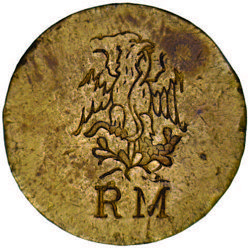
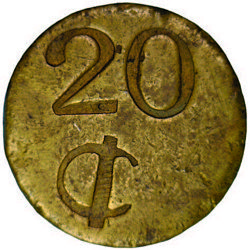
GB-248, A-EM 7 struck in brass (enlarged)
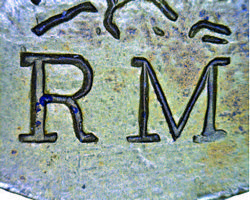
GB-248, A-EM 7 struck in brass (enlarged)
The second type has an obverse with the National Eagle positioned above three diamonds and the initials A.D.J. which is an abbreviation for AMECAMECA DE JUAREZ, while the reverse has the denomination (20) superimposed over a raised centavos sign and is listed by Guthrie and Bothamley as GB-250 and by Carlos Amaya as A-EM 11.
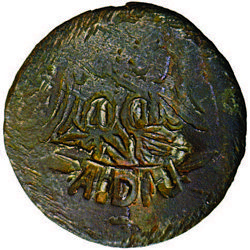
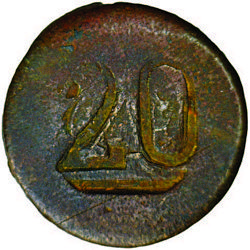
GB-250, A-EM 11 struck in copper (enlarged)
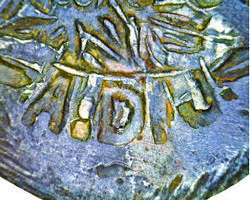
Close up of obverse initials A.D.J. (GB-250, A-EM 11)
RM Type Varieties
The RM type was struck on large 24.5mm, 3mm thick brass planchets and at least two obverse varieties are known to exist. One is commonly referred to as a ‘round’ nopal (cactus) variety, while the other is referred to as the ‘square’ nopal. The round nopal variety is pictured, but not described as such by Guthrie and Bothamley as GB-248 while the square nopal is not pictured nor is it listed within their publication; however Carlos Amaya catalogued this variety in his publication as A-EM 10.
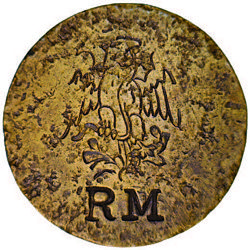
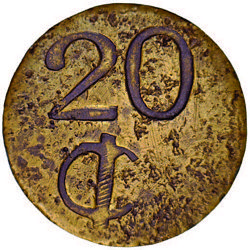
GB-248, A-EM 7 (enlarged), round nopal
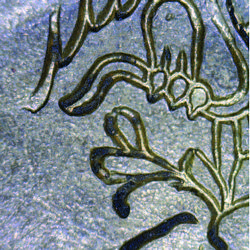
detail of round nopal & non-incuse snake tail
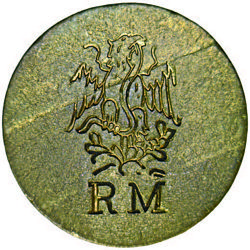
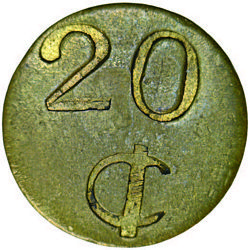
GB-UNL, A-EM 10 (enlarged), square nopal
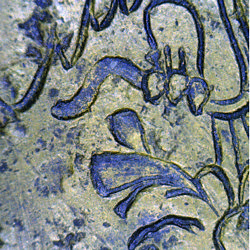
detail of square nopal & incuse snake tail
Analysis of the RM Round Nopal Obverse Variety
Although Guthrie and Bothamley didn’t mention any obverse varieties or GB-248 obverse variations, there exist some noticeable differences for the round nopal variety. Specifically, some of the differences include the snake above the eagle’s head (missing or not), line at the top of the eagle’s head and back of the neck (broken or solid line), snake across the eagle’s chest (broken or solid line), and the letter M of the initials RM (solid or broken line). More study would be needed to determine if multiple obverse punches were used, or if these differences are merely due to weak strikes or strikes using worn or damaged punches.
The following four examples are of some differences on the obverse National Eagle.
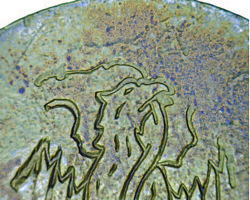
Example #1-1
Example #1-1 – snake above the eagle’s head, solid line at the top of the eagle’s head, back of neck and snake across the chest.
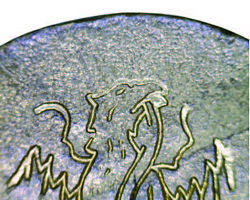
Example #1-2
Example #1-2 – missing snake above the eagle’s head, solid line at the top of the eagle’s head, small broken portion (line) on the back of the neck, solid lines on the snake across the eagle’s chest.
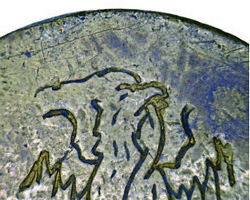
Example #1-3
Example #1-3 – snake above the eagle’s head, broken line at the top of the eagle’s head, solid line on the back of the eagle’s neck, broken line on the snake across the eagle’s chest.
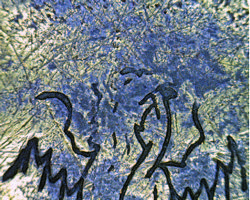
Example #1-4
Example #1-4 – missing snake above the head, broken line at the top of the eagle’s head, broken line on the snake across the eagle’s chest.
The following three examples are of some differences on the obverse initials RM.
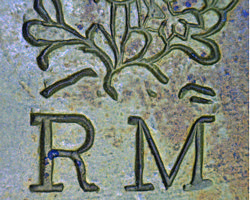
Example #2-1
Example #2-1 – solid lines throughout on the initials RM; as well as two solid notches or lines above the rightside of the letter M.
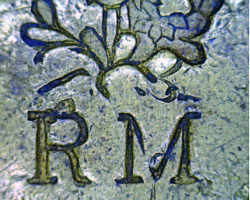
Example #2-2
Example #2-2 – broken line on the initial M of RM; as well as a shortened top notch or line above the right side of the letter M.
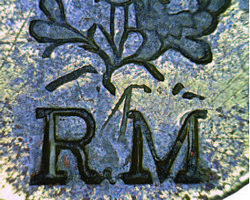
Example #2-3
Example #2-3 – solid line on the initial M of RM; as well as a shortened top notch or line above the right side of the letter M.
Analysis of the RM Round Nopal Reverse Variety
The reverse on the round nopal variety is basically the same for each coin except for the placement of the 20 (denomination) and centavos sign which is not always in the same position since each one was individually handstamped; thereby different from coin to coin. Since these were hand-stamped, each coin made is somewhat unique: therefore it shouldn’t necessarily be construed as a separate variety in this author’s opinion.
The following examples of the reverse denomination and centavos sign help highlight some of the many possible variations.
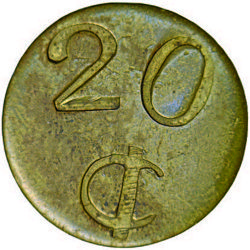
Example #3-1
Example #3-1 – low zero tilted to the right, centavos sign slash tilted to the right and placed very low and center.
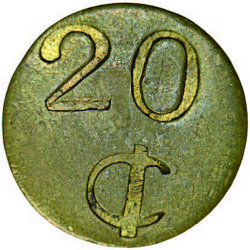
Example #3-2
Example #3-2 – low slightly tilted zero, centavos sign slash tilted to the right placed very low and center.
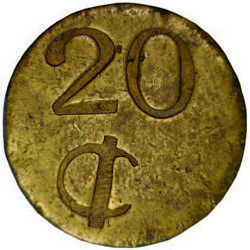
Example #3-3
Example #3-3 – two and zero are almost even, centavos sign slash tilted to the right placed below the two
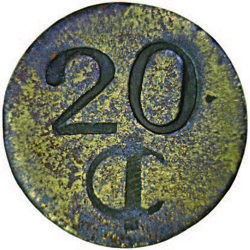
Example #3-4
Example #3-4 – high slightly tilted zero, centavos sign vertical slash not tilted and centered below the two and the zero.
Analysis of the RM Square Nopal Variety
The square nopal variety die is quite a bit different compared to the round nopal variety. Although the obverse and reverse characteristics are close in overall design to the round nopal variety, it is quite clear that this coin was minted using a completely new set of dies. The square nopal variety is easily distinguished when compared to the round nopal by the square nopal and incuse snake tail. This coin also did not use separate punches as were used for the round nopal and was struck using a fixed position die.
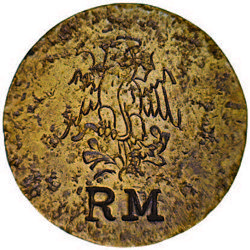

Example #4-1
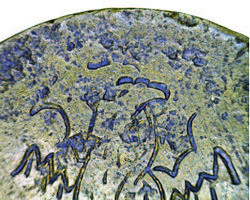

Close up of eagle Close up of RM
Example #4-1: planchet is very pitted and has well defined coin attributes.
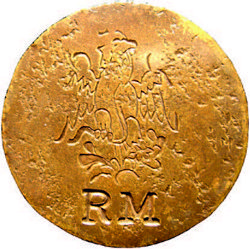
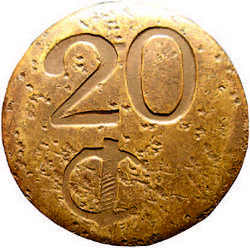
Example #4-2
(photos courtesy of Angel Smith)
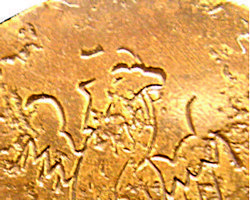
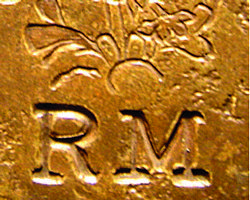
Close up of eagle Close up of RM
Example #4-2: planchet is very pitted like example #4-1 and the coin has the same attributes and die placement such as the National Eagle, denomination, centavos sign and slanted lines within the vertical bar.
Analysis of several square nopal specimens, as well as coin scans, show that each coin is basically the same in regards to the National Eagle, denomination, centavos sign placement; as well as the slanted lines within the vertical bar of the centavos sign. Planchet surface ranges vary from pitted to smooth. Since this coin is so much different than other Amecameca coins of the period, more analysis is needed to see if it is a new variety or possibly spurious.
Analysis of the A.D.J. Variety
Another 20 centavos issue from Amecameca which is known as the initials A.D.J. type is generally smaller in size (19.5-20mm vs. 24.5mm) and weight (4.5-5 grams vs. 12-12.5 grams) than the RM type and were struck in copper and brass while the RM type is generally known to have been struck only in brass, although Amaya has catalogued a copper strike (with no photo) as A-EM 9.
One particular A.D.J. variety (GB-251, A-EM 13) was struck on the same size brass planchet as was used for GB-248, A-EM 7 and is considered quite rare. Otherwise, the most common A.D.J. variety comes in copper and is generally crudely struck. There is also an unlisted GB variety of GB-250 struck in brass, which is the same general size and weight as the copper variety and is considered very scarce. Amaya catalogued this coin as A-EM 12.
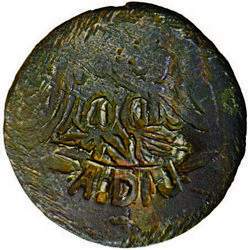
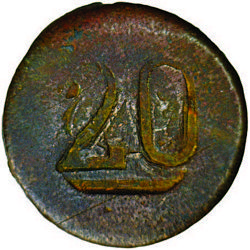
GB-250, A-EM 11 struck in copper (enlarged)
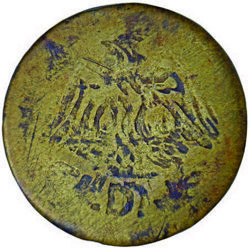
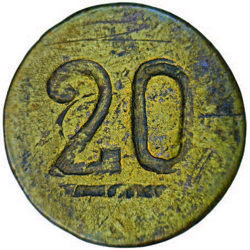
GB-UNL (GB-250), A-EM 12 struck in brass (enlarged)
This coin appears to have been struck using single punches for each side of the coin and did not use separate punches for the denomination, centavos sign, eagle and A.D.J. initials as is seen on the RM type. It is well known that there are at least two sets of obverse and reverse dies (GB-250, A-EM 11 and GB-251, A-EM 13) for this type; however further study is needed to determine if there are any additional punch varieties.
Rarity of the Amecameca 20 Centavos Coinage
Although any one of the varieties of the Amecameca 20 centavos coins can be viewed as scarce to very scarce, most are not rare by any means. The exceptions are GB-250 (GB-UNL), A-EM 12 struck in brass and GB-251, A-EM 13, neither of which are often offered for sale at shows or auctions. GB-248, A-EM 7 is arguably the most common of the Amecameca 20 centavos and overall a scarce coin. It is hard to say which one of the various obverse eagle and RM die variations is common, scarce or rare. In time, some may become known to be rarer than others, but only through more analysis and detailed study of this series.
